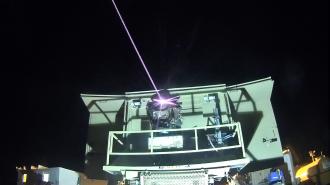“It may sound like science fiction, but it’s real.”
Thus tweeted Israeli prime minister Naftali Bennet, accompanied by a highly-produced video of Israel’s new laser-based air defense system, the “Iron Beam,” destroying incoming ordinance in the Negev Desert.
The successful testing of the device joins a recently announced US Navy test of a similar weapons platform called Layered Laser Defense (LLD). LLD was tested at the High Energy Laser Systems Test Facility at White Sands Missile Range in New Mexico, as laser air defense systems begin to move from concept to action.
“Innovative laser systems like the LLD have the potential to redefine the future of naval combat operations,” Rear Adm. Lorin C. Selby, Chief of Naval Research, said in a statement.
Laser focused: The US Office of Naval Research (ONR) has been looking at laser-based weapons since the 1980s, Interesting Engineering reports, and as the technologies powering lasers improved, the weapons slowly marched towards reality.
In 2014, the ONR completed a laser air defense system test on the USS Ponce. The amphibious transport ship’s laser weapons system, dubbed LaWS, is “more precise than a bullet,” the Ponce’s captain, Christopher Wells, told a CNN crew during a demonstration in July 2017. (It’s faster than a speeding bullet, too: the beam moves — naturally — at the speed of light.)
And it could bring that precision to bear on a number of targets.
“It’s not a niche weapon system like some other weapons that we have throughout the military where it’s only good against air contacts, or it’s only good against surface targets, or it’s only good against, you know, ground-based targets – in this case this is a very versatile weapon, it can be used against a variety of targets,” Wells told CNN.
In recent tests, the LLD shot down a drone playing the role of a subsonic cruise missile, as well as fixed-wing aircraft and quadcopters, per Interesting Engineering.
Meanwhile, in Israel, the country’s Iron Beam air defense system accurately intercepted and shot down anti-tank missiles, mortars, and rockets, the AP reports.
The LLD system is also capable of non-lethal deterences like optical “dazzling” and the disabling as sensors, as well. Because the systems are fully electric, they do not require potentially dangerous propellants.
The US and Israel aren’t the only powers looking to lasers, with the French Navy announcing it intends to do so as well.
The cost of war: While the Israeli government claims the Iron Dome — which fires interceptor missiles at incoming rockets — has a 90% success rate, the country’s traditional air defense system has an obvious drawback: the cost.
Israeli PM Bennett has previously noted that it costs only hundreds of dollars to fire a rocket into Israel, but the Iron Dome costs hundreds of thousands dollars per shootdown.
In contrast, Bennett said the Iron Beam can take out incoming weapons for roughly $3.50, Insider reported (although that probably doesn’t include the upfront cost of building the lasers).
The future of lasers: Although the US Navy has said it has no current plans to deploy the LLD in the field, Israel is looking to roll out the Iron Beam within the year.
American and Israeli forces aren’t the only ones seeking to harness the precision, versatility, and cost effectiveness of laser weapons systems, with the French Navy, one of the world’s larger and more formidable, announcing its intention to do the same last year.
We’d love to hear from you! If you have a comment about this article or if you have a tip for a future Freethink story, please email us at tips@freethink.com.
